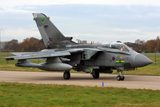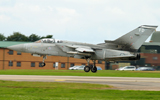Panavia Tornado

Panavia Tornado F.3 - ZE158
The Panavia Tornado was produced from a consortium of companies in the UK, Germany and Italy. The weapon system was designed from the beginning to operate from extremely short or battle-damaged runways, with the assumption being the worst-case scenario brought on from an all-out invasion with the Soviet Union.
An air-to-air Tornado model had always been envisioned in early planning, and a feasibility study of an air defence variant was first conducted in 1968. The Tornado was subsequently selected to meet the UK's 1971 requirement for an air defence fighter armed with BAe’s Skyflash medium range air-to-air missile and fitted with an advanced radar. Formal development of the Tornado, was designated and authorized in March 1976.
The first of 3 Tornado prototypes flew for the first time on 27th October 1979. The F.2 first flew on March 5th, 1984, was first delivered to the RAF on 5th November 1984, and its short career came to an end four years later when the new F.3s came into the RAF. Some F.2 airframes were later updated to F.3 standard, although lacked the engine upgrade and were known as F.2A, as attrition replacements. Only one F.2A remains flying, this is with QinetiQ at MoD Boscombe Down. The Tornado F.3 made its maiden flight on 20th November 1985. It entered service in July 1986.
Three base Tornado variants are available in the forms of the IDS, ECR and the ADV. The IDS and ECR variants are the most closely related though all share an 80% commonality in systems and parts. The IDS represents the base interdiction and strike warplane model, capable of achieving high-success in the ground bombing role utilizing a variety of munitions. The ECR represents the electronic combat and reconnaissance role, armed with a variety of radar tracking and jamming equipment systems.
The ADV variant represents the air-defense fighter with updated tracking systems and a full-compliment of air-to-air weaponry. The ADV features an extended fuselage and is armed with a base arrangement of 4 x AMRAAMS. The ADV model also features only a single 27mm Mauser-type cannon instead of the 2 featured in the IDS and ECR models. The ADV is also powered by the Turbo-Union RB199-34R Mk 104 powerplant.
The RAF ordered 173 Tornado ADV's, the first 18 of which were delivered in interim F2 standard with less powerful Mk 103 engines, while the definitive F.3 features the RB199 Mk 104. F.2s have been retired from service. F.3s are being fitted with JTIDS and about 100 are being modified to carry ASRAAM and AIM-120 missiles.



The Panavia Tornado has been called to action in the Persian Gulf War, Kosovo and Operation Iraqi Freedom with good results. The Tornado also replaced the American-built F-4 Phantoms in defence of the Falkland Islands near Argentina. Some Tornado elements also take part in NATO air defence for other European countries such as Lithuania. Its multi- role efficiency and long-range on standard fuel arrangement has made the Tornado a quite capable aircraft.
It made its combat debut in the 1991 Gulf War with 18 aircraft deployed to Dhahran, Saudi Arabia. However, they did not get the opportunity to engage any enemy aircraft. The F.3 lacked modern IFF and a full suite of defensive aids, thus they flew patrols further back from Iraqi airspace where encounters with enemy aircraft were less likely. After 1991 combat operations continued as the southern no-fly zones over Iraq were patrolled. The Tornados flew from Saudi Arabia under Operation Resinate South. On average six aircraft were involved. These operations continued right up until 2003 when Iraq was invaded again. Operation Telic saw 14 F.3s deployed to Saudi Arabia. The F.3s were, unlike during the 91 Gulf War, deployed deep into Iraq both before and after the "shock and awe" air strikes. Again no air-to-air victories were scored as the Iraqi Air Force flew no sorties at all during the 2003 campaign.
After 19 years, the replacement for the F.3 is now in full swing, as production of its successor, the Eurofighter Typhoon, has started. In July 2004, the UK Ministry of Defence announced that one squadron stationed at RAF Leeming, would be disbanded in October 2005, which was the start of the end for the F.3 fleet. The RAF Tornado F.3 fleet was retired in March 2011, with 80% of it's parts being recycled to help keep the GR.4 fleet airworthy until it's retirement due date in 2015.
| Model | Production |
|---|---|
| F.2 | 18 |
| F.3 | 152 (15 F.2 conversions) |
| GR.1 | 228 |
| GR.1A | 30 (16 GR.1 conversions) |
| GR.1B | 26 GR.1 conversions |
| GR.4 | 142 GR.1 conversions |
| GR.4A | 30 (25 GR.1 conversions) |
| IDS | 507 (359 German AF, 100 Italian AF, 48 Saudi AF) |
| Length: | 18.68 m (61.4 ft) |
| Width: | 13.91 m (45.8 ft) |
| Height: | 5.95 m (19.6 ft) |
| Accommodation: | 2 |
| Hardpoints: | 4 |
| Empty Weight: | 14,500kg (31,970lb) |
| MTOW: | 27,895kg (61,700lb) |
| Max Speed: | Mach 2.2 |
| Max Range: | 1850km (1000nm) |
| Rate-of-Climb: | ? |
| Service Ceiling: | 70,000ft |
| Engine: | 2 x Turbo-Union RB199-34R Mk 104 turbofans with afterburning, producing 40.5kN (9100lb) dry and 73.5kN (16,520lb) each |
| Armament Standard: | One IKMA -Mauser 27mm canon. |
| Armament Optional: | Four underfuselage Skyflash AAMs and two AIM-9L Sidewinders on each wing pylon. |
